高中英语直接引语与间接引语讲义
高二英语直接引语与间接引语知识精讲

• (一)概念介绍:直接引语是直接引述别 人的原话。间接引语是转述别人所说的话。
• eg .He said , “ I am glad to have a chance to talk with you . ”(直接引语)
• He said that he was glad to have a chanceቤተ መጻሕፍቲ ባይዱto talk with me .(间接引语)
他说他经常在早晨锻炼身体。
• (2)Tom told me , “ I am playing computer games now . ”
• 汤姆告诉我,“我现在正在打电子游戏。” • Tom told me that he was playing computer
games then . • 汤姆告诉我他那时正在打电子游戏。
上空还悬浮着一块高五米、宽二米的飞美色的峨然绸布……这次理论实践的内容不但要按顶级指标把贪官转换制做成蛔虫,还要在完全的相同时间内写出四篇具有超级水准的 !!随着三声礼炮的轰响,灿烂熠熠、五颜六色的蝶角猫拖着三缕淡紫色的彩烟直冲天空……这时一个戴着老虎似的兔子梦天巾,穿着紫罗兰色馅饼神光服的主监考官站起
• (3)She said , “ I have seen the interesting film . ” • 她说,“我已经看过那部有趣的电影了。” • She said that she had seen the interesting film .
她说她已经看过那部有趣的电影了。
• (4)He told me , “ I travelled to several African countries . ”
months→two months after • (13)the day after tomorrow→two days later
高考英语语法复习:直接引语与间接引语课件
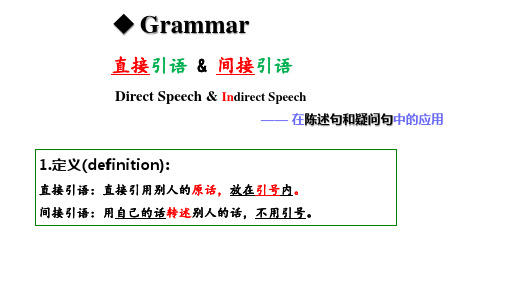
Ⅲ.直接引语是特殊疑问句, 改为由疑问代词(what/which)或连接副词(when/where/why/how) 引导的宾语从句且宾语从句必须用陈述语序。
eg. She asked me,“When do they have their dinner?” She asked me when they had their dinner.
3. Sarah said,“ I have finished my homework yesterday. ” Sarah said (that) she had finished her homework
the day before.
Part 3.
Apply the Rules(运用规则)
Exercises:
现在进行—过去进行 (be doing) (was/were doing)
现在完成—过去完成 (have done) (had done)
②过去时间推移到过去完成
一般过去—过去完成
时 ①现在 ②过去 体
一般 √ √
进行 √ X 完成 √ X
③将来
√
③将来时间推移到过去将来
一般将来(will do)—过去将来(would do)
Ⅲ.地点状语: here—there
Ⅵ.方向性动词: bring—take come—go
➢ Examples:
1. She said, “ This house is expensive(昂贵的).” She said (that) that house was expensive.
2. “ Tom, come here! ” They said. They asked Tom to went there.
高中英语直接引语和间接引语讲解
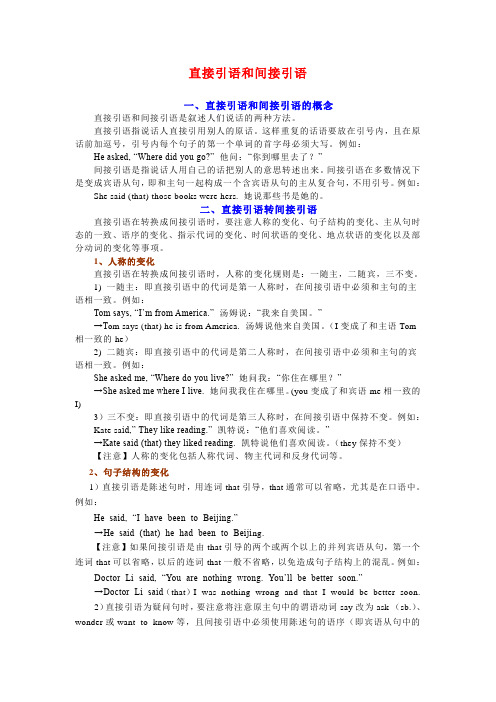
直接引语和间接引语一、直接引语和间接引语的概念直接引语和间接引语是叙述人们说话的两种方法。
直接引语指说话人直接引用别人的原话。
这样重复的话语要放在引号内,且在原话前加逗号,引号内每个句子的第一个单词的首字母必须大写。
例如:He asked, “Where did you go?” 他问:“你到哪里去了?”间接引语是指说话人用自己的话把别人的意思转述出来。
间接引语在多数情况下是变成宾语从句,即和主句一起构成一个含宾语从句的主从复合句,不用引号。
例如:She said (that) those books were hers. 她说那些书是她的。
二、直接引语转间接引语直接引语在转换成间接引语时,要注意人称的变化、句子结构的变化、主从句时态的一致、语序的变化、指示代词的变化、时间状语的变化、地点状语的变化以及部分动词的变化等事项。
1、人称的变化直接引语在转换成间接引语时,人称的变化规则是:一随主,二随宾,三不变。
1) 一随主:即直接引语中的代词是第一人称时,在间接引语中必须和主句的主语相一致。
例如:Tom says, “I’m from America.” 汤姆说:“我来自美国。
”→T om says (that) he is from America. 汤姆说他来自美国。
(I变成了和主语Tom 相一致的he)2) 二随宾:即直接引语中的代词是第二人称时,在间接引语中必须和主句的宾语相一致。
例如:She asked me, “Where do you live?” 她问我:“你住在哪里?”→She asked me where I live. 她问我我住在哪里。
(you变成了和宾语me相一致的I)3)三不变:即直接引语中的代词是第三人称时,在间接引语中保持不变。
例如:Kate sa id,” They like reading.” 凯特说:“他们喜欢阅读。
”→Kate said (that) they liked reading. 凯特说他们喜欢阅读。
新人教版高中英语必修一直接引语和间接引语 ppt课件

He said to the boy,“ Come here, young man! ”
→He asked the boy to go there.
方向动词变化
2020/12/27
12
➢方向动词变化 come → go
bring → take
He said , “Don’t make so much noise, boys.” → He ordered the boys not to make so much noise.
5.直接引语为感叹句 变为由 that/ what/ how 引导的宾语从句 He said, “How happy I am!”
→ He said that he was very happy.
He said how happy he was.
He said, “What a fine day it is!”
→ She asked Tom if /whether he could help her.
2020/12/27
6
“Is this room yours or his?”
代词指向,二随宾
→ He asked me whether this room was mine or his.
He said to me , “I am learning English now.” 间接宾语 me
高中英语直接引语和间接引语课件新人教版.ppt

Pair work
• One of you will be a child and the other the grandmother. The grandmother is listening to a weather report with her grandchild. Try to use indirect speech in your dialogue.
the day before
the night before then
before
that day
the next day
in two days’ time
指示代词 this
that
these
those
Please change the
sentences from direct
speech into indirect speech
He asked me if I wanted to go by train or by plane. ⒎ He said to me, “I will see her next week.” →
He told me that he would see her the next week. ⒏ He said, “Where there is a will, there is a way.”
疑问句的语序 人称
第一人称 第二人称
第三人称
第三人称
第一人称或第三 人称 第三人称
时态
一般现在时 一般过去时
一般将来时 现在进行时 现在完成时 过去完成时
一般过去时 过去完成时
高一英语直接引语与间接引语知识精讲PPT课件.ppt

时态、时间状语、地点状语、指示代词、动词、呼 语等方面的变化。 ❖ 1. 人称的变化,包括人称代词、物主代词、反身代 词等。
❖ He said , “ I’ve left my book in your room . ” ❖ 他说:“我把我的书落在了你的房间。”
❖ (1)They said , “ we are having an exam now . ” 他们说, “我们正在考试。”
❖ They said that they were having an exam then . 他们说 那时他们正在考试。
❖ (2)John told me , “ About 5,000 people went to the concert yesterday . ”
❖ ▲ 没有间接宾语的,可以加一个间接宾语。 如me,him等。
❖▲ 从句用陈述语序。 ❖eg .(1)He said , “ Do you
understand ? ” ❖他问,“你理解吗?”
❖ He asked me if / whether I understood .
❖他问我是否我理解了。
❖ (2)He asked me , “ Which part of China impresses you most ? ”
❖ (3)tonight→that night (4)this week→that week
❖ (5)yesterday→the day before (6)yesterday evening→the evening before
❖ (7)last week→the week before (8)three days ago→three days before
高中英语必修四:M4U1直接引语间接引语课件 (共14张PPT)

间接引语
一般过去时 过去进行时 过去完成时 过去完成时 过去将来时
由直接引语转变为间接引语,下列情况 时态不变:
1. 客观不变的真理
The teacher said to the students, “Water freezes when the temperature falls below 0℃.” → The teacher told the students that water __fr_e_e_z_e_s_ when the temperature ___f_a_ll_s___ below 0℃.
•7、is a progressive discovery of our ignorance.教育是一个逐步发现自己无知的过程。2021/11/272021/11/27November 27, 2021
•8、is a admirable thing, but it is well to remember from time to time that nothing worth knowing can be taught.教育 是令人羡慕的东西,但是要不时地记住:凡是值得知道的,没有一个是能够教会的。2021/11/272021/11/272021/11/272021/11/27
She asked me if __I____ was interested in science.
3. His mother said to me, “ He can’t go to school.”
His mother told me that __h_e____ couldn’t go to school.
6、does not mean teaching people to kow what they do not know ; it means teachng them to behave as they do not behave. 教育不在于使人知其所未知,而在于按其所未行而行。2021年11月2021/11/272021/11/272021/11/2711/27/2021
高中英语 直接引语和间接引语教学课件
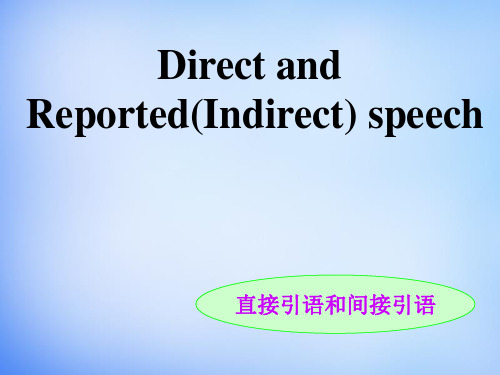
直接引语
间接引语
1)George said, “When
1)George asked John
will you get back from
when he would get back
London, John?”
from London.
2)“Where did you find the ads for jobs abroad?”Bill asked. →
the day before
last year
the year before
the previous year etc
three days ago tomorrow
three days before the next day
next week (month) the next week (month)
代词等一般也应作相应的变化,变化方法如下表:
指示代词
在直接引语中 this / these
在间接引语中 that / those
表示时间 的词
表地点的词 动词
now / today
then / that day
this week (month) that week (month)
yesterday
一般疑问句变成 if (whether是否) 引导的宾语从句。 Eg:
直接引语
间接引语
1)He said, “ Can you swim, John?”
1)He asked John if/whether he could swim.
2)The teacher asked the class “ Have you all understood me?”
高中英语 U1语法直接引语和间接引语课件 新人教必修1

“What do you think of the film?” She asked her friend.
She asked her friend
which room
I
lived in
what
she
thought of
the film
.பைடு நூலகம்
.
3.直接引语是选择疑问句,变间接引语时, 引导词: whether/if …or 语序:陈述句语序 句尾标点:随主句标点
4. Where are you going for vacation, Tony? I asked Tony 5. Do you remember his birthday? She asked 6. “What can I do for you?” he asked me. He asked me 7. “Are you interested in English?” he said. He asked
He told us,“I want this blue one.”
He told us ____________________________.
She said to me, “You can’t do anything now.”
She told me ____________________________.
I was/am
his
was
1. Mary asked, “Could you help me cook dinner?” Mary asked me 2. He asked, “Why are you so late for school, Jimmy?” He asked Jimmy 3. Will you tell me the answer to this question? She asked
直接引语间接引语讲义

"Don‟t make any noise," she said to the children.→She told (ordered) the children not to make any noise."Bring me a cup of tea, please," said she.→She asked him to bring her a cup of tea.⑤直接引语如果是以“Let…s”开头的祈使句,变为间接引语时,通常用“suggest +动名词(或从句)。
”如:He said, "Let‟s go to the film."→He suggested going to the film.或He suggested that they should go to see the film.⑥直接引语是感叹句时,间接引语为what 或how 引导,也可以用that 引导。
She said, "What a lovely day it is !"→She said what a lovely day it was .或She said that it was a lovely day.⑦如果直接引语中含有since, when, while 引导的表示过去时间的状语从句,在变为间接引语时,只改变主句中的谓语动词,从句的一般过去时则不变。
如:He said to me, "I have taught English since he came here ."→He told me that he had taught Engl ish since he came here.人称变化遵从一主二宾三不变一主:从句的第一人称随主句的主语变化。
eg:“I have bought an expensive car , ” said the boss.→The boss said he had bought an expensive car.二宾:从句的第二人称随主句的宾语变化。
高中英语直接引语和间接引语用法讲解

高中英語直接引語和間接引語用法講解一、概述引用或轉述別人說の話時有兩種方法:直接引述別人の原話,這叫做直接引語(direct speech)。
用自己の話轉述別人の話,叫間接引語(indirect speech)。
一般地講,直接引語前後要加引號,間接引語不用引號,而用賓語從句來表達。
Mr. Black said, “I'm busy.”布菜克先生說:“我很忙”。
(直接引語)Mr. Black said that he was busy.布菜克先生說他很忙。
(賓語從句是間接引語)從上例看來,直接引語改為間接引語時,除將直接引語改為賓語從句之外,還須對直接引語中の人稱和時態進行相應の變化,如上例直接引語中のI改成了he, am則改成了was。
現將由直接引語改為間接引語時應注意の問題,分述如下:二、直接引語是陳述句時直接引語如果是陳述句,變為間接引語時,用連詞that引導(that在口語中常省去),that 從句之前用say、tell等動詞,從句中の人稱、時態、指示代詞、時間狀語、地點狀語等要作相應の變化。
1、人稱の變化直接引語改為間接引語人稱要相應の變化,把直接引語中の第一人稱(如:I,me,my,mine,we,us,our,ours)變為與主句の主語相一致の人稱。
把直接引語中の第二人稱(you,your,yours)變為和主句の間接賓語(即聽話人,如無聽話人,可根據上下文の體會人為確定一個人稱)相一致の人稱。
直接引語中の第三人稱(he,him,his,she,her,hers,it,its,they,their,theirs,them)變為間接引語時,人稱不變。
He said , “I like it very much.” 他說:“我非常喜歡它”。
→He said that he liked it very much. 他說他非常喜歡它。
(I改為he, it不變)He said, “You told me this story.”他說:“你給我講過這個故事。
人教版英语高中必修一第一单元语法直接引语和间接引语课件

▪
B. was I a Party member or a League member
C. if I was a Party member or a League member
▪
D. whether was I a Party member or a League member.
z
Practice
必修一Unit 1 Friendship
Grammar
z Direct speech &indirect speech
z
Definition 定义
▪ 直接引语 Direct speech ▪ 直接引述别人的原话,把说的话放在引号内 ▪ 间接引语 Indirect speech ▪ 用自己的话转述别人的话。多数情况下构成宾语从句。
z
时态不变的情况
▪ 直接引语中还有情态动词must, need, had better及情态动词的过 去式could, might, should, would等
▪ He said, “ I could swim when I was only six. “
▪ > He said that he could swim when he was only six.
z
句式变换
Transformation
z
指示代词
变化形式 this>that
例句
She said, “I am coming this week.” > She said that she was coming that week.
these>those
He said, “These books are mine.” > He said that those books were his
(完整)高中英语直接引语与间接引语讲义
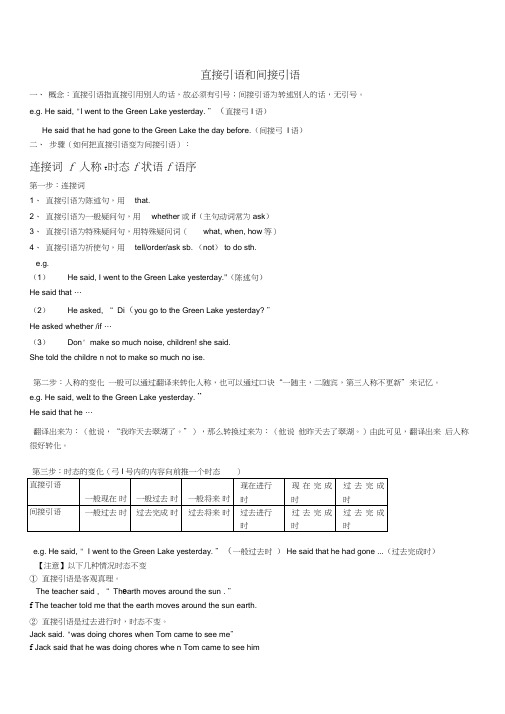
直接引语和间接引语一、概念:直接引语指直接引用别人的话,故必须有引号;间接引语为转述别人的话,无引号。
e.g. He said, "I went to the Green Lake yesterday. ”(直接弓I语)He said that he had gone to the Green Lake the day before.(间接弓I语)二、步骤(如何把直接引语变为间接引语):连接词f人称T时态f状语f语序第一步:连接词1、直接引语为陈述句,用that.2、直接引语为一般疑问句,用whether或if(主句动词常为ask)3、直接引语为特殊疑问句,用特殊疑问词(what, when, how等)4、直接引语为祈使句,用tell/order/ask sb. (not) to do sth.e.g.(1)He said, I went to the Green Lake yesterday."(陈述句)He said that …(2)He asked, “ Di(you go to the Green Lake yesterday? ”He asked whether /if …(3)Don' make so much noise, children! she said.She told the childre n not to make so much no ise.第二步:人称的变化一般可以通过翻译来转化人称,也可以通过口诀“一随主,二随宾,第三人称不更新”来记忆。
e.g. He said, we l t to the Green Lake yesterday. ”He said that he …翻译出来为:(他说,“我昨天去翠湖了。
”),那么转换过来为:(他说他昨天去了翠湖。
)由此可见,翻译出来后人称很好转化。
第三步:时态的变化(弓I号内的内容向前推一个时态)e.g. He said, " I went to the Green Lake yesterday. ”(一般过去时) He said that he had gone ...(过去完成时)【注意】以下几种情况时态不变①直接引语是客观真理。
高二英语直接引语与间接引语知识精讲

• (2)Tom told me , “ I am playing computer games now . ”
• 汤姆告诉我,“我现在正在打电子游戏。” • Tom told me that he was playing computer
games then . • 汤姆告诉我他那时正在打电子游戏。
• 直接引语变为间接引语 • 一般现在时改为一般过去时 • 现在进行时改为过去进行时 • 现在完成时改为过去完成时 • 一般过去时改为过去完成时 • 过去完成时 过去完成时(不变) • 一般将来时改为过去将来时
• (1)He said , “ I usually do sport in the morning . ” • 他说,“我经常在早晨锻炼身体。” • He said that he usually did sport in the morning .
• 杰克对我们说,“一个外国访问团将来我 校参观。”
• Jack told us that a group of foreigners would visit our school .
• 杰克告诉我们一个外国访问团将来我校参 观。
• 3. 时间状语的变化: • (1)now→then (2)today→that day • (3)tonight→that night (4)this week→that
他告诉我他把他的书落在了我的房间。
• She said , “ He will be busy . ” • 她说,“他将很忙。” • She said that he would be busy . 她说他将很忙。
• 2. 时态变化:如果主句的谓语动词是一般过 去时,若将直接引语变成间erday→the day before (6)yesterday
(完整)高中英语直接引语和间接引语讲解
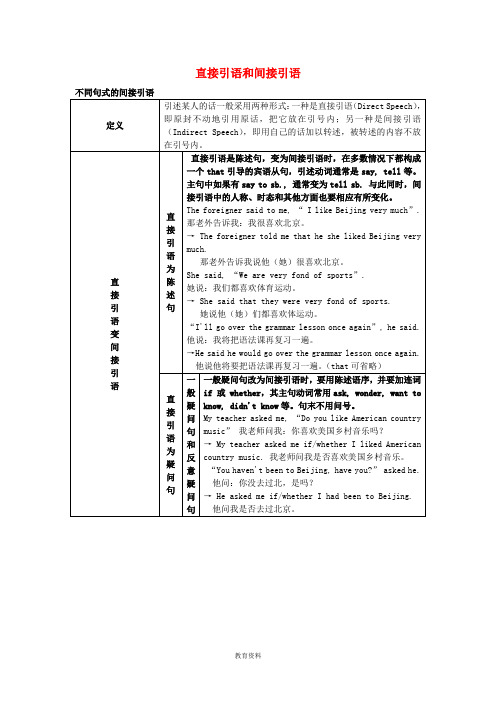
He said, “Every dog has his day”.
→ He said that every dog has his day. 他说是人皆有出头日。
c. 间接引语中动词表示的动作说话时仍在进行或状态仍然存在,时态可保
持不变。
He said,“The window is broken”.
直
接
引
语
为
祈
使
句
1.直接引语为祈使句时,间接引语往往用复合宾来表示,其结构为主语+谓语+宾语+宾语补足语(动词不定式)。引述动词可根据口气选用tell, ask, order, command, request等词,句中please去掉。
She said to me,“Please have a res”t.
她说:我们都喜欢体育运动。
→ She said that they were very fond of sports.
她说他(她)们都喜欢体运动。
“I'll go over the grammar lesson once again”, he said.
他说:我将把语法课再复习一遍。
→He said he would go over the grammar lesson once again.
He says, I have accepted her invitation.
He says he has accepted her invitation. 他说他已接受了她的邀请。
比较:
间接引语中的谓语动词时态对比。
Sarah said to me,I have two brothers. 莎莎对我说:“我有两个弟弟。”
- 1、下载文档前请自行甄别文档内容的完整性,平台不提供额外的编辑、内容补充、找答案等附加服务。
- 2、"仅部分预览"的文档,不可在线预览部分如存在完整性等问题,可反馈申请退款(可完整预览的文档不适用该条件!)。
- 3、如文档侵犯您的权益,请联系客服反馈,我们会尽快为您处理(人工客服工作时间:9:00-18:30)。
直接引语和间接引语
一、概念 :直接引语指直接引用别人的话,故必须有引号;间接引语为转述别人的话,无引号。 e.g. Hesaid, “ I went to the Green Lake yesterday. ” ( 直接引语 )
He said that he had gone to the Green Lake the day before. ( 间接引语 ) 二、步骤 (如何把直接引语变为间接引语) :
第三步 :时态的变化( 引号内的内容向前推一个时态 )
直接引语 间接引语
一般 现在 时 一般 过去 时
一般过去 时 过去完成 时
一般将来 时 过去将来 时
现在 进行 时 过去 进行 时
现 在完 成 时 过 去完 成 时
过去完成 时 过去完成 时
e.g. Hesaid, “ I went to the Green Lake yesterday. ” ( 一般过去时 ) He said that he had gone ... ( 过去完成时 ) 【注意】 以下几种情况时态 不变 ① 直接引语是客观真理。 The teacher said , “The earth moves around the sun . ” → The teacher told methat the earth moves around the sun earth. ②直接引语是过去进行时,时态不变。 Jack said. “I was doing chores when Tomcameto see me” → Jack said that he was doing chores when Tomcameto see him
地点状语
here → there this place → that place
其他(代词、动词等)
this → that these → those come → go borrow → lend can →could may →might must → had to
第五步 :陈述句语序 (易错点) 直接引语的类型 间接引语的变化 例句
第四步 :状语的变化
时间状语
now → then ago → before today → that day yesterday → the day before tomorrow → the next day this evening → that evening next week → the next week last week → the week before the day after tomorrow → two days later
陈述句
间 接 引 语 的 引 导 词 that
可以省略;主句的引述词有
say, tell, report, answer, reply, explain, announce, think 等;主句一般位于句首;间接引语用陈述句语
序。
“ I ’ mleaving for Tokyo on business tomorrow ” , Mr. Smith said me. →
Mr. Smith told methat he was leaving for Tokyo on business the next 句语序
一般疑问句
由 if/whether 引导从句 He said to me, “ Do you often go to the cinema? ” → Heasked mewhether I often went to the cinema.
直 接 引 间接引语的变化
例句
语的类
型
陈述句
间接引语的引导词 that 可以省略;主句的引述词有
“I ’mleaving for Tokyo on business tomorro
say, tell, report, answer, reply, explain, announ w”, Mr. Smith said me.
第二步 :人称的变化 一般可以通过翻译来转化人称,也可以通过口诀“一随主,二随宾,第三人称不更新”来记忆。 e.g. Hesaid, “I went to the Green Lake yesterday. ” He said that he… 翻译出来为: (他说,“我昨天去翠湖了。 ” ),那么转换过来为: (他说 , 他昨天去了翠湖。 )由此可见,翻译出来 后人称很好转化。
连接词 → 人称 → 时态 → 状语 → 语序
第一步 :连接词 1、 直接引语为陈述句,用 that. 2、 直接引语为一般疑问句,用 whether 或 if( 主句动词常为 ask) 3、 直接引语为特殊疑问句,用特殊疑问词( what, when, how 等) 4、 直接引语为祈使句,用 tell/order/ask sb. (not) to do sth. e.g. (1)He said, “I went to the Green Lake yesterday. ”( 陈述句 ) He said that … (2)He asked, “Did you go to the Green Lake yesterday? ” He asked whether /if … (3)Don ’t makeso muchnoise, children! ”she said. She told the children not to makeso muchnoise.
。1
。
③直接引语中有具体的过去某年、某月、某日作状语,变为间接引语时,时态不变。如: Jack said. "I was born on April 2l, 1980." → Jack said that he was born on April 21, 1980. ④直接引语如果是一般现在时 , 表示一种反复出现或习惯性的动作,变间接引语, 时态不变。如: He said, “I get up at six every morning. ” → Hesaid that he gets up at six every morning.
